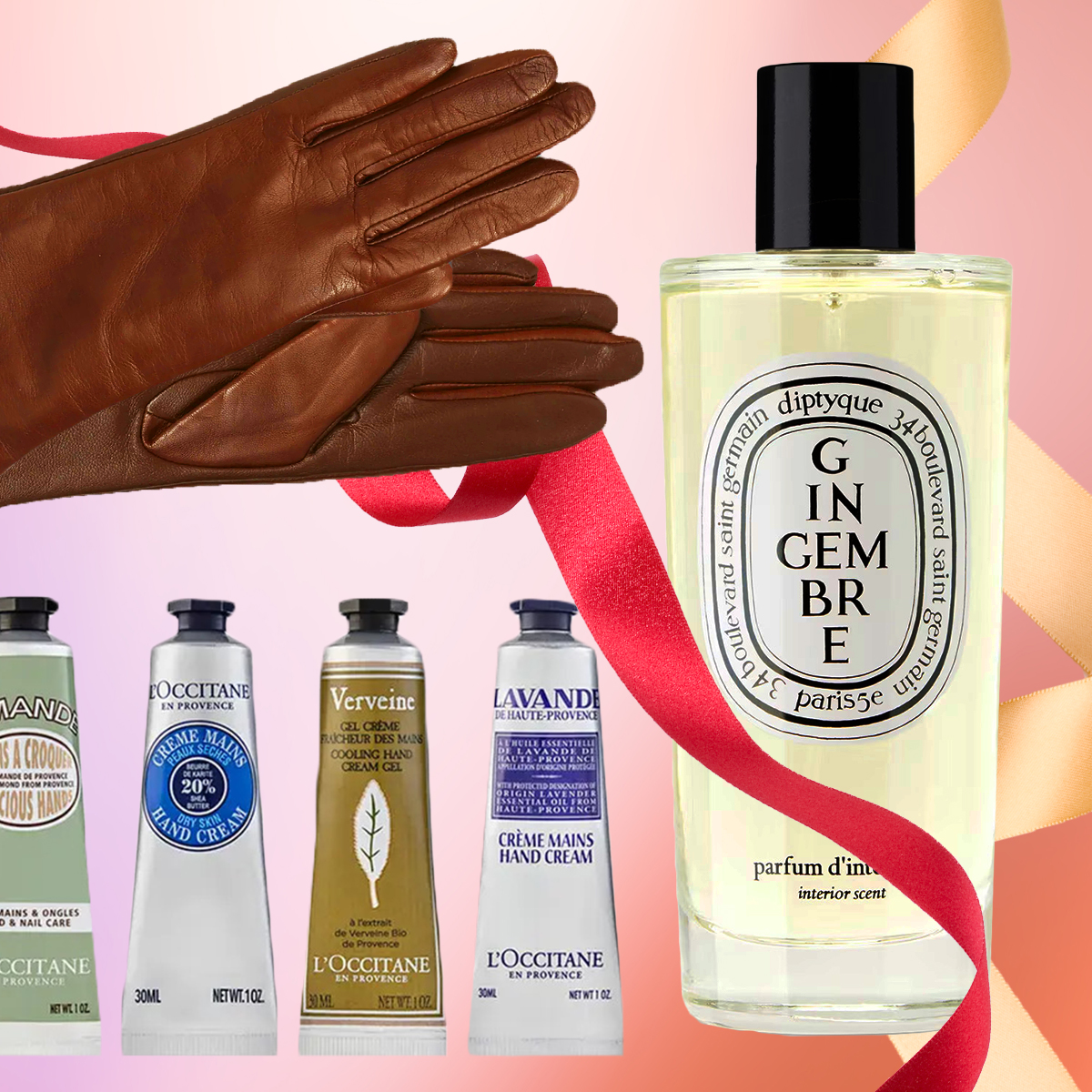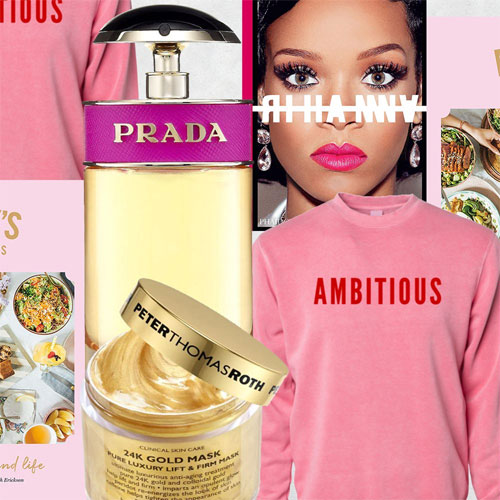Season’s (and Other...) Greetings
Fans from a new digitally savvy generation are putting their stamp on the traditional greeting-card business. They’re embracing it and disrupting it—as they do.

MAIN IMAGE. FROM LEFT: Noteworthy Paper & Press Ladybugs letterpress blank card, $15 for three. Hallmark Thanks a Bunch note cards with coordinating lined envelopes, $12 for 10. Hartland Brooklyn You Brighten My Day die-cut blank card, $6. Erika Firm Be Merry holiday card, from $4. Egg Press Party Cheetah Happy Birthday letterpress card, $6.
Digital natives are, by definition, supposed to do everything online. They’re deep and vocal advocates for the environment and probably didn’t even learn cursive in school. And yet they love to send actual written-on-paper, licked-and-stamped, dropped-in-mailboxes greeting cards. It’s estimated to be a $7–$8 billion industry—one that many had forecasted as on its way to the grave. And yet, thanks to millennials and Gen Z, the incredibly analog business is experiencing a rebirth.
“People may be surprised,” says Winnie Park, the CEO of Paper Source, “but our number-one customers for paper goods are actually millennials. They are our fastest growing segment.” Blame screen burnout, for one—the same thing that has millennials snapping up vintage typewriters and real-film Polaroid cameras. Grandmacore, if you will. Dayna Isom Johnson, Etsy’s resident trend expert and a judge on NBC’s Making It (who, at age 35, is herself a millennial), started seeing “the grand-millenial trend in things like eyeglass chains and the return of brooches.” And now, greeting cards. “Because our lives are so filled with technology, it’s really great to prioritize something that’s a personal gesture, that’s handwritten. It’s super thoughtful, different, and actually stepping outside of that digital box.”
Being real is why Victoria Venturi, also 35, started Paper Epiphanies, her letterpress company in Portland, Oregon. When her father died in 2013, she says, “I received dozens of cards that neither comforted me nor represented the person my father was or our relationship. What I really wanted was a card that said, ‘This is so fucking awful,’ and instead I received ‘…on angels’ wings.’” The desire to create cards that her millennial-and-younger customers would see and immediately say, “This is so me,” led to her start-up. Her buyers have “scroll fatigue.” They recognize an “authentic voice” and, she says, are drawn to cards for life events or sentiments that established brands don’t cater to but that matter to her peers. (Examples: “fourth trimester” moms, breakups and divorce, and “funny shit.”)
Stickii assorted stickers, sold by the sheet or by subscription for $10 a month. Mr. Boddington’s Studio From My Bar Cart to Yours holiday card, $18 for six.
Digital natives, unlike boomers before them, “don’t need a reason” to send cards, says Venturi. “With some older generations, you really saw a seasonal purchasing pattern: They bought at Valentine’s Day; they sent holiday cards. Gen Z is down to send cards whenever.” Everyday categories and just-because cards are big for this cohort. Or sometimes they upend the reason to send a card in the first place: “The Mother’s Day category has totally changed,” she says. “Now women are kind of identifying each other and saying, ‘Happy Mother’s Day. You’ve got this.’”
The first Christmas cards date back to Victorian times, dreamed up in 1843 by British civil servant Henry Cole, who wanted a quick yuletide shout-out for friends. The idea caught on, and by the 1880s, Louis Prang (credited with printing the first mass-produced commercial Christmas cards in America) was churning out more than five million a year. Today, Americans buy about 6.5 billion cards annually, according to the Greeting Card Association (GCA), with 1.3 billion selling during the holiday season alone. It’s big business, though it’s one that is waning. Last year, Walmart and CVS, among other stores, announced that they would cut display space for cards. The parent company of Papyrus filed for bankruptcy. The decline in brick-and-mortar bookstores—not to mention COVID-related closures—affects an industry that relies on the tactile nature of its wares, as well as the in-person impulse to buy at the spin of the card rack.
But the annus horribilis of 2020 segueing into 2021 is actually looking like a pretty decent time to be in greeting cards. A majority of Americans polled (56 percent) believe there will be fewer in-person holiday celebrations, according to research by Ipsos and Shutterfly, a company that makes cards from your personal photos. Instead, they’ll be wishing season’s greetings on paper; nearly one in five people polled are sending holiday cards for the first time this year. “This number jumps to 40 percent for millennials,” says Jim Hilt, president of Shutterfly. Searches for cards on Etsy were up 73 percent from August to October (compared with that time last year). “Social distancing is not allowing us to really see our friends and family,” says Etsy’s Johnson, “and so sending a really beautiful, unique, handmade card is a great way to connect and to kind of up-level your sentiment and your thoughtfulness.”
Stay In The Know
Get exclusive access to fashion and beauty trends, hot-off-the-press celebrity news, and more.
Shop Small (and Local, Artisanal, and Individual)
In some ways, greeting cards are the anti-group-text. The more personal, the better in terms of both the card and the store selling it. “This generation loves independent businesses, and they love local,” says Chandra Greer, founder of an eponymous Chicago card company. “That’s a huge part of it: The cards they’re buying are actually made by a physical person who poured a lot into it. They like craftsmanship; they like authenticity.”
Even from the mass-market companies, millennials and Gen Z are “purchasing higher value cards with a handmade, boutique style,” says Dawn Garvey, chief financial officer of Designer Greetings. Buyers are willing to spend for high-quality and/or interactive goods. Think embellishments like glitter, ribbon, and jewels, pop-ups, or cards with a little something extra, like an enclosed holiday ornament or even a mini cake. (Yes, it’s edible.) “We’ve found that eight out of 10 millennials keep the cards they’re given because they are so important to them as capstones of a relationship,” says Lindsey Roy, chief marketing officer of Hallmark, one of the big two greeting-card companies, along with American Greetings.
FROM LEFT: American Greetings Life Is Full of Transitions card, $4; available at Target in summer 2021 (shop similar). Red Cap Cards Let’s Party Disco Glam die-cut blank card, $6. Mr. Boddington’s Studio Ti Amo blank card, $5. Red Cap Cards Vintage Stamp Thank You card, $6. Rifle Paper Co. Happy Holidays die-cut card, $5 each or $20 for eight.
For a card to resonate with this cohort, the voices must be not only genuine but also genuinely inclusive. The card makers we spoke to are all cognizant of representation. “We want everyone to find a card that speaks to them,” says Kelly Ricker, chief creative officer of American Greetings, “whether it’s wedding cards for two husbands or two wives or congratulations for a baby to two moms.” Mariam Naficy, founder of online card company Minted, says that she goes to great lengths to provide diverse and representational photos in her card templates, even though they will be replaced with customers’ own snaps. All Minted card designs are crowdsourced, voted on by customers—which allows for some “very fresh, young millennial writing” in the company’s offerings, she says. Those with subscriptions also get to select the content: “We surveyed the customers and felt that people wanted to be the ones picking the cards,” she says. “It’s such a personal choice around your relationship with the recipient.”
Not feeling seen was the reason Jasmin Foster, 31, started her own stationery line, Be Rooted. “I was really frustrated. I never felt like myself or my community were reflected in the design or the sayings that were in greeting cards or journals or thank-you cards,” she says. “So instead of waiting for someone else to do it, I decided to fill that gap so that other Black and brown young girls could walk in the door and feel like there was a brand that really stood behind what they needed.” In the wake of Black Lives Matter protests last summer, the GCA initiated a pitch program solely for Black-owned companies and Black makers, giving them access to a panel of top retailers, sales reps, and international distributors. A statement on the organization’s website reads: “We have been listening, reflecting and learning and…our industry is not racially diverse.”
Recently, Venturi collaborated with Gia Graham, a Black Atlanta-based artist, on a line of cards with quotes by Black women. “Can we create something that’s really beautiful and authentic but still use it as a way to move that needle forward?” Venturi posits. “The representation is important, but what’s going on behind the scenes? Have the [card companies’] boards changed? Have their artists changed? Have their writers changed? What else are we doing as companies to continue to really just not be performative but own that message?” Authentically diversifying and not just “checking a box” brings in younger consumers, she says: “They care about the brands they buy from, what they stand for. And they’re really savvy at identifying that kind of tokenism.”
Lovepop Happy Holidays Cardinal 3D card, $13 each or $50 for five. For $5 extra, the company will upload your message and a photo and even mail it for you.
If digital natives can’t find a card that speaks like them, they’ll DIY. “They love anything they can put their individual creativity and stamp on,” says Hilt. His fastest-growing customer base is the “really mobile-centric” 18–34 crowd. “They want even more options. They want to exactly customize their wedding website or invite or holiday cards to the nth degree.”
No Luddites Here
“A misconception is that [cards are] somehow antiquated,” says Anna Bond, 36, cofounder of Rifle Paper Co. Quite the contrary. Millennials and Gen Z are full of ways to make IRL cards high-tech. Even pre-pandemic, the online segment of the business was expanding, growing (from 2014 to 2019) by 9.3 percent to total $713.5 million, including e-commerce of physical cards as well as e-cards (through Paperless Post or JibJab). And there are plenty of cyber innovations in the way younger people access this old-school medium, the cherry-on-a-sundae of cards for screen-first customers.
Some cards—such as those from iGreet—combine the physical with the virtual via an augmented-reality (AR) app that plays a personalized video. Hallmark’s AR cards, says Roy, “bring the story to life. People are always excited about a new and different way to send a card.” On Etsy, you can download and print high-design cards via PDF files. Ditto for Rifle Paper Co. (an option the brand added in response to the pandemic). Both Paper Source and Rifle Paper Co. allow customers to integrate paper invites seamlessly with digital platforms, like Paperless Post (meaning you can send the same design across different mediums, as well as monitor event RSVPs online).
For a generation of people accustomed to leaving their John Hancock on forms and contracts via e-signature, sometimes handwriting is expendable—even on physical cards. Several companies offer a “direct send” option in which you select a handwriting font and message, then send it in an analog card with the press of a button. “We are digital first, and more and more people want to be able to send that card without sitting down and writing it,” says Wombi Rose, 34, cofounder of Lovepop, which makes involved and ornate pop-up cards that he says sell especially well with customers ages 25–34. The Felt app bills itself as “Handwritten Cards for the Modern World,” which can be “sealed, stamped, and mailed—all from your phone or tablet.”
Shoppers lamenting the closure of many a card shop, but who still want to craft their salutation themselves, can have all the elements of a perfect parcel sent to their home. At Stickii, a sticker and stationery subscription company, founder Rita Jiang, 28, sends monthly packs of greeting-card adornments in three you-pick personalities (cute, vintage, and pop). Last month, the “cute” people got Christmas-themed stickers—which she previewed on Instagram. “If you don’t celebrate, you can go online and switch,” says Jiang. Nicely Noted’s subscription sends customers a packet of three letterpress cards per month. (Even the provided matchy postage stamps feel on-theme and edited.) “I thought sending a fun collection of cards and stamps every month would take one more harried errand off of people’s plates,” says founder Perry Nelson.
Save the USPS
Young Americans do not want their favorite neighborhood stamp purveyor—you know, the United States Postal Service—to go out of business, scene of many a harried errand or not. The embattled governmental agency brought us our absentee ballots and rare feelings of connection during a pandemic. Customers are “very passionate about saving the post office,” says Greer, noting that anytime her company produces a card, or even just an Instagram post, around the topic, “they absolutely love it.”
The USPS appreciates, and returns, the good wishes. “What we’ve seen over this past year or so is—with the struggles of the pandemic and everything else—that people do care about getting their mail, especially in rural areas,” says Bill Gicker, director of stamp services for the U.S. Postal Service. “Because often that’s the only thing you’re getting—something from the Postal Service.” When it comes to thinking up ideas for new stamps (the accessories of your greeting-card wardrobe, sort of like earrings), the USPS has a civilian review board (the Citizens’ Stamp Advisory Committee) and, he says, the organization has made sure to include a couple of millennials in the mix. “What we’re looking for is someone to see things from that generational vantage point,” says Gicker. That means someone who is not necessarily “an expert in that generation but of that generation and is bringing ideas from within that generation.” He adds: “Gen Z and millennials are going to be even bigger than boomers, so we don’t want to lose touch with them.”
Millennials and Gen Z love to support the U.S. Postal Service by buying stamps and sending snail mail.
According to Minted, more than half of those surveyed want to send holiday cards to support the USPS. Says Naficy, “Social distancing makes actual mail more valuable.” And unfortunately, many of us will have plenty of downtime this year to write and read cards. “This holiday, people are going to use cards and gifts as a way to stay connected because they know they won’t be able to necessarily see people they are close to,” says Hilt. Since COVID, Foster says she has been getting cards and letters from friends—not pen pals—that she used to see in person, whether by popping over to their house or getting on a plane. “I think,” she says, “that this time has really caused us all to reflect differently on how we want to stay connected with our loved ones.” Thankfully, there’s a greeting card for that.
Photography: Kathryn Wirsing
Set Design: Miako Katoh

Click here to read more from our Holiday issue.
Maria Ricapito is a writer who lives in the Hudson Valley.
-
 Adria Arjona Smells Irresistibly Delicious Courtesy of This $48 Hair Oil
Adria Arjona Smells Irresistibly Delicious Courtesy of This $48 Hair OilPlus the makeup routine that helps her feel "like a rebel."
By Ariel Baker Published
-
 Princess Anne's Unexpected Suggestion About Mike Tindall's Nose
Princess Anne's Unexpected Suggestion About Mike Tindall's Nose"Princess Anne asked me if I'd have the surgery."
By Amy Mackelden Published
-
 Queen Elizabeth's "Disapproving" Royal Wedding Comment
Queen Elizabeth's "Disapproving" Royal Wedding CommentShe reportedly had lots of nice things to say, too.
By Amy Mackelden Published
-
 When Will ‘Virgin River’ Season 5, Part 2 Come Out?
When Will ‘Virgin River’ Season 5, Part 2 Come Out?It's time to get into the holiday spirit (yes, really).
By Quinci LeGardye Published
-
 The Holiday Issue
The Holiday IssueThis season, it's all about giving—to yourself, to others—and giving better.
By Marie Claire Editors Published
-
 Jessica Chastain: The Good Fight
Jessica Chastain: The Good FightHer passion for telling women’s stories has won her a Best Actress title, inspired a production company, and made her a bold-faced name within the industry. But the Hollywood heavyweight isn't stopping now.
By Justine Harman Published
-
 Sir Elton John Performed as a Surprise Guest at Saks' Holiday Window Unveiling
Sir Elton John Performed as a Surprise Guest at Saks' Holiday Window UnveilingBy Gabrielle Ulubay Published
-
 The Best Gifts for Gen Z, According to Zoomers
The Best Gifts for Gen Z, According to ZoomersWith insight from several in-the-know zoomers.
By Emma Childs Published
-
 Here’s How to Choose a Holiday Gift for Your Boss
Here’s How to Choose a Holiday Gift for Your BossShe wants everything on this list, and yours will, too.
By Brooke Knappenberger Last updated
-
 Of Murder and Motherhood
Of Murder and MotherhoodTheir children are gone but these women are united in their fight for justice and answers.
By Katya Cengel Published
-
 48 Trendy Gifts for Every Woman in Your Life
48 Trendy Gifts for Every Woman in Your LifeWhether it's for a birthday, holiday, or just to say "I miss you."
By Rachel Epstein Published